Elusive Muse just loves UPPERCASE Magazine. UPPERCASE publishes books and magazines for the creative and curious: products that spark the imagination and inspire creativity. The eponymous magazine, now in its sixth year, is loved by readers around the world and has been recognized for its design excellence. Their books profile up-and-coming artists or explore emerging trends in design and creativity.
To subscribe to UPPERCASE or to purchase one of their many books, visit the UPPERCASE Shop here.
They view everything they publish as an opportunity to create something special, so each product has high production values and attention to detail. A playful exploration of creativity, an affinity for vintage ephemera, and a love of typography are some elements common to many of their publications. To read more about UPPERCASE publisher / editor / designer Janine Vangool, please scroll.
Q+A WITH UPPERCASE PUBLISHER / EDITOR / DESIGNER JANINE VANGOOL
 How would you describe the philosophy of UPPERCASE?
How would you describe the philosophy of UPPERCASE?
The tagline for UPPERCASE magazine is “for the creative and curious” and this really is the somewhat loose guideline to content appearing in the magazine. Though the content is based in graphic design, illustration and crafting as its starting points, with such a broad statement the articles can be quite eclectic. I think it is this curious bent that makes the magazine unique and hopefully surprising with each new issue.
We like to support the creative endeavours of our readership and therefore much of the written content, photography and illustration is commissioned from our subscribers, open calls for submissions and through connections made in our social media circles. I strongly believe that the magazine is a collaborative effort with its readership.
How do you come up with a theme for each issue?
I categorize and archive all the submissions and suggestions that come my way, as well as favourite blog posts, Flickr images, Etsy shops, tweets… When you’re looking at so many things, you start to see common threads and emerging themes. So an issue’s themes are a combination of these discoveries and topics of interest to me personally.
What are the benefits to publishing a paper magazine in a “digital age”?
The physical format of UPPERCASE magazine is part of its appeal—it is something that you hold, carry, collect and keep. I always strive to make each issue an object that is well-crafted and has attention to detail in its paper stock, special print processes or formats… these are the things that make print so special. Unlike digital magazines, which I think promote attention deficit, when you’re reading a paper magazine you have more commitment and a more intimate experience!
Though the expense to produce a paper magazine is considerable, I think my readership feels the same way I do and are willing to invest in a long-term relationship.
{ These answers originally appeared on Melanie Falick Books’ blog. }
Please tell us a little bit about yourself, your background, where you are from, and how/why you started UPPERCASE.
I graduated from the Alberta College of Art & Design in Calgary, Alberta, Canada, back in 1995. I originally imagined that I would get a graphic design job at a creative firm, learn the ropes for a few years and then start my own company. In actuality, the local job choices were slim. I did get a position in a small firm and my job was mostly mundane and uncreative and I was miserable. After half a year, a freelance opportunity came about and I decided to quit the safety of the day job and work on the freelance job instead. It was the best decision to have made! I met lots of people who liked my work and work ethic and were my champions. Suddenly I was freelancing full time on very covetable jobs in the local Calgary arts community as Vangool Design & Typography.
After working freelance out of my home for a decade, I was ready for a change of scenery. Art Central was a new concept in the city’s downtown: a central 3-story building with art galleries, small boutiques and studios. Enthralled with the concept, I envisioned a public design office slash bookstore slash gallery where people could see design in action. So I moved my design company into Art Central and created a new brand called UPPERCASE. Though initially UPPERCASE was meant to be a small side project to my design career, I quickly became addicted to creating my own products to sell on my shelves. Starting with notecards, I progressed to handmade notebooks, hand sewn paper pouches, assembled packs of wood type and other type treasures… it was fun to conceptualize, design, package and sell my own things.
When designing the UPPERCASE logo and concept, though, my ultimate goal was to publish my own books. In 2007, I published The Shatner Show and hosted the companion gallery exhibition: 76 illustrations inspired by the life and career of Canadian icon William Shatner of Star Trek fame. It was an odd choice to start my publishing experience, given that I was not a trekkie or super fan, but I was intrigued by the possibilities and the potential interest there would be in such a project. The show was a success, Shatner endorsed the book project (and even mentions it in his autobiography!) and it definitely put my little gallery on the map. The biggest effect was that I knew this was the course for me — conceptualizing content and bringing them to life suited me to a T.
In November 2008, an off-and-on-again magazine I had worked for finally stopped publishing. I took what I learned from that experience (mainly how NOT to run a magazine) combined it with my passion for creativity and launched UPPERCASE the quarterly magazine for the creative and curious in January of 2009 (the first issue came out in April of that year.)
Now with more than a dozen issues and many books under my belt, I’m more enthusiastic than ever about UPPERCASE and all its potential.
You are involved in so many creative projects — books, design, publishing, the list goes on. Could you describe your creative work process for us? How is it different for each type of work? Where do you get your inspiration?
Though I do produce a lot of different things (magazine, books, blog), the main thread through it all is a love of good, inspiring content. I have always been a designer that responds to the written word. I need good content in order to be a good designer. As a publisher, I can work with content that I love—resulting in products in which I have put my heart and soul into. With the Suitcase Series, for example, each book is a monograph all about a particular artist. I get to immerse myself in their world and create a book that is equal to that experience. Camilla Engman, the lovely Swedish artist and blogger, was my first subject in the series. I travelled to Scandinavia to meet her and we worked on the book together to create something that was a synthesis of both of our creative visions.
For the magazine and potential book projects, inspiration comes from surrounding myself with possibilities. Through blogs, Flickr, Etsy, Twitter, emails, conferences, books and collections of things that I love… it’s all around me both in a physical way and also virtually. I begin to see common features, happy coincidences, trends… and inspiration comes from that.
Do you have any mentors or particular artists/designers/writers who inspire you?
I am very inspired by the talented people who subscribe to UPPERCASE magazine! Whenever possible, I make the effort to get to know who they are… through Google, blogs, Flickr, etc I find out what they do, what they like… Very often our subscribers become subjects or contributors to the magazine.
Over the past few years I have developed an entirely new skill set: editing and writing. In this area, Steven Heller, the prolific and prominent graphic design writer, has been someone whom I admire.
I have always been inspired by the San Francisco-based publishing company Chronicle Books. As a student, I fantasized about moving to San Francisco and working for them. Though that didn’t happen, I did learn a lot about good design by studying their books. When I was a retailer, I learned about book distribution and carried their titles. As a publisher, I admired their marketing, the diversity of their titles, and their commitment to quality. Then in issue #6 of the magazine, I had a photographic featured called Shoegazing. Kate Woodrow, and editor at Chronicle Books, liked the concept and suggested that we turn it into a notecard series. I was able to curate and design the package, becoming both a Chronicle Books author and designer (they even let me put the UPPERCASE logo on the package front!) This was a dream come true.
What would you advise someone who is trying to develop a personal style?
Make sure that you keep it personal! Don’t try to force something that feels unnatural or fake. No one will respond to it. I sincerely pour all my efforts and available funds (and then some) into everything that I produce. There is no compromising. The phrase “labour of love” rings true with UPPERCASE. This hard work, sincerity and commitment is the UPPERCASE style.
What role do you feel social media has played in your success?
These are vital. My blog had a small but loyal following before I launched my print magazine. When deciding to launch the magazine, I hoped that if just a modest percentage of those followers decided to take a risk and subscribe to the magazine, then it would be a feasible project. The publisher of the magazine I used to work for recommended Twitter so I did my first tweet the day that first issue of the magazine arrived from the printer. Now four years later, we are approaching 10,000 followers of my Twitter feed! Hopefully someday all of those people will become subscribers! (UPPERCASE currently hovers around 2200 subscribers.)
Supporting yourself as an artist/designer is an overwhelming topic for many people. Could you give us some advice about developing multiple income streams and other strategies that have worked well for you in your creative career?
Since I began freelancing so soon out of college, I was “young and carefree” and my only responsibility was paying rent. Freelancing is not a career path that allows you to predict your income so I quickly became tolerant of the fluctuations. This tolerance and ability to take calculated risks is something that I am grateful for now since my income has never been steady or a sure thing in all of my adult life!
The one thing I have always been sure of is that I have the ability and talent to work; this gives me confidence to take risks. I opened UPPERCASE gallery a few months before I got married; the magazine launched before my son was born. Looking at UPPERCASE now, it would have been near impossible to launch it all now! Now I support my husband (he’s a novelist) and my son—ensuring that UPPERCASE can support our family is my job.
So self-confidence is important and risk tolerance is an asset as well.
I am amazed by the number of books and magazines you publish. How do you do it all? Could you please share some of your time management strategies with us?
If I stop and think of all the things I’ve done in the past few years, I’d be too exhausted to do anything in the future! I think I have some sort of memory block—I forget all of the blood, sweat and tears and only remember the good stuff! I did post something relevant to this question on my blog:
People often ask “How do you do it?” The answer is simple and difficult at the same time. I just do. Each magazine issue, each book, has its own set of steps. If I just do one thing, then the next, and the next… just keep going and it will get done. Some of the steps are easy and joyful (design, editing, creating), other steps are long, arduous, stressful and not much fun at all (logistics, bills, shipping). But even when the steps seem painfully impossible, I know that if I just push my way through, things will get done. And so even getting one step done in the long process becomes a reward in itself.
Do you have a “typical” work day? Please tell us how you organize your daily schedule.
There is no typical day with a nearly two-year old to look after! Usually, I look after him in the mornings while my husband heads out to the local coffeehouse to work on his second novel. After lunch, I walk downtown to the UPPERCASE studio and hunker down to work until 5 or 6pm. Scattered throughout the day (and evenings and weekends and holidays), I check and respond to emails and editorial concerns.
What is unique about being in Calgary? Do you feel that the landscape, climate, and/or culture influences your work?
In my freelance days, being in Calgary was a benefit: the city is big enough to have lots of cultural events to keep a designer like me busy. But not too big that the plum jobs would automatically go to the big companies. Now, Calgary is just a nice home base to raise a family. I’ve since closed the retail/gallery aspect of UPPERCASE and my space in Art Central is primarily an office. UPPERCASE’s community is now mostly virtual, online.
If you could give advice to someone who would like to start pursuing their creative dreams or take them to the next level, what would it be?
Identify whether want you want is a fantasy (i.e. not likely to happen) or something that exists in the realm of possibility. If it is possible, identify all of the steps, both big and small, that would be required to make the dream happen. Start with step one and plug away!
For example, I knew I wanted to publish my own books someday, so when designing the logo for UPPERCASE, I made sure that it would work well on the spine of a book! Though actually publishing was a few years off, I had accomplished one of the steps earlier on.
{ These answers are an edited version of questions answered for Stephanie Levy’s Creative Courage online course. }


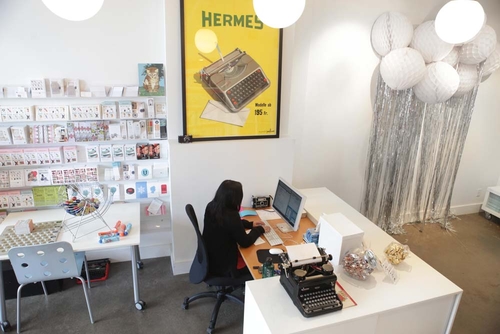
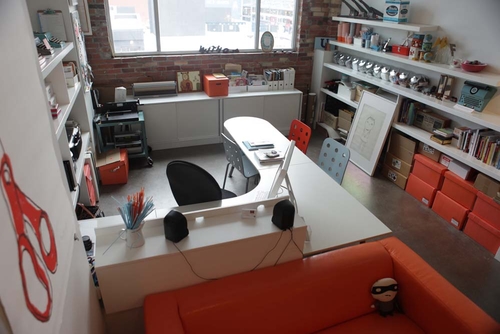

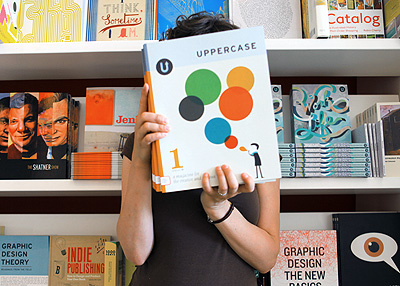
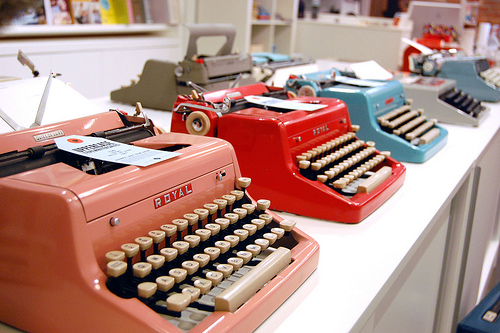
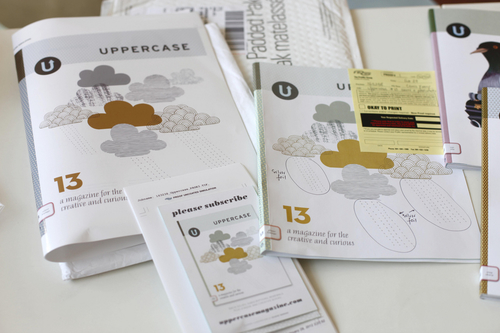
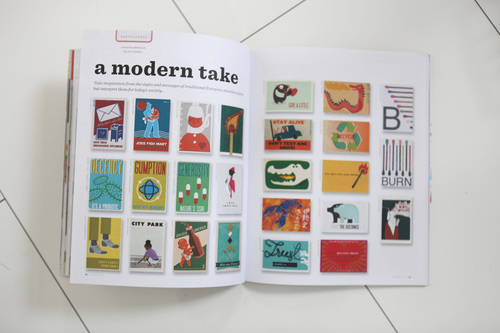
What a great interview. I love the magazine.
Inspiring! Thank you for sharing!